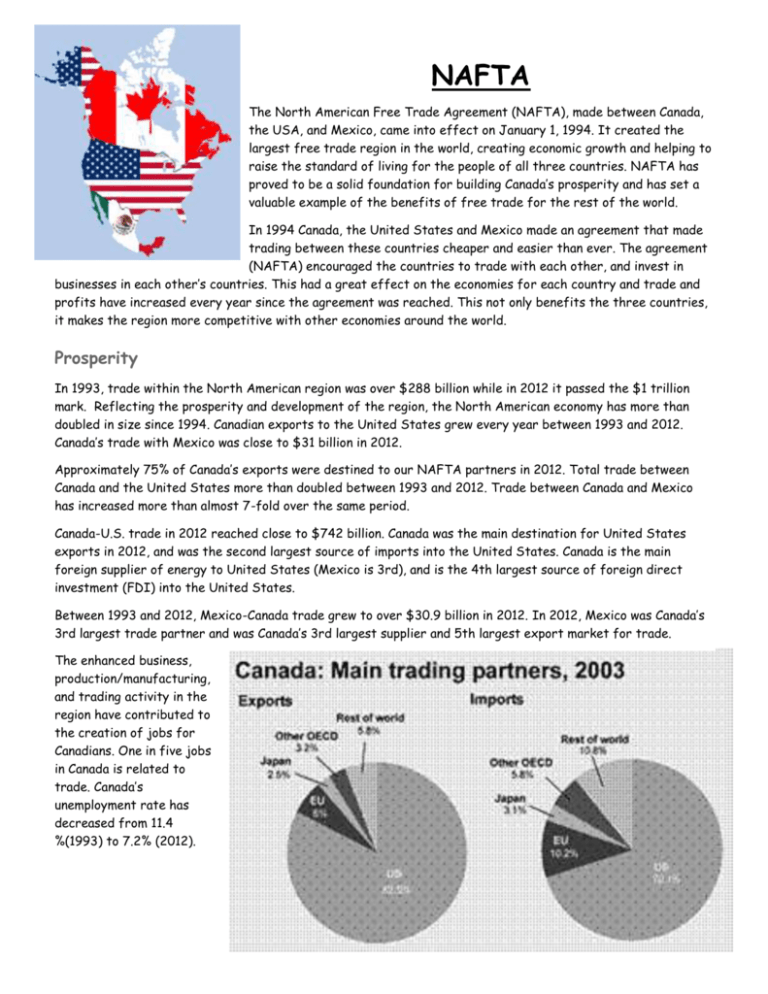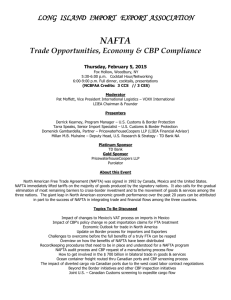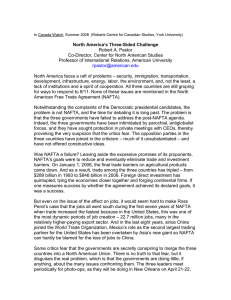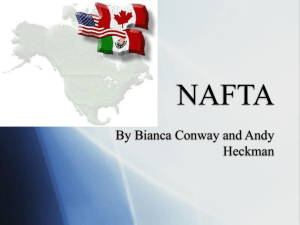Article: NAFTA
advertisement

NAFTA The North American Free Trade Agreement (NAFTA), made between Canada, the USA, and Mexico, came into effect on January 1, 1994. It created the largest free trade region in the world, creating economic growth and helping to raise the standard of living for the people of all three countries. NAFTA has proved to be a solid foundation for building Canada’s prosperity and has set a valuable example of the benefits of free trade for the rest of the world. In 1994 Canada, the United States and Mexico made an agreement that made trading between these countries cheaper and easier than ever. The agreement (NAFTA) encouraged the countries to trade with each other, and invest in businesses in each other’s countries. This had a great effect on the economies for each country and trade and profits have increased every year since the agreement was reached. This not only benefits the three countries, it makes the region more competitive with other economies around the world. Prosperity In 1993, trade within the North American region was over $288 billion while in 2012 it passed the $1 trillion mark. Reflecting the prosperity and development of the region, the North American economy has more than doubled in size since 1994. Canadian exports to the United States grew every year between 1993 and 2012. Canada’s trade with Mexico was close to $31 billion in 2012. Approximately 75% of Canada’s exports were destined to our NAFTA partners in 2012. Total trade between Canada and the United States more than doubled between 1993 and 2012. Trade between Canada and Mexico has increased more than almost 7-fold over the same period. Canada-U.S. trade in 2012 reached close to $742 billion. Canada was the main destination for United States exports in 2012, and was the second largest source of imports into the United States. Canada is the main foreign supplier of energy to United States (Mexico is 3rd), and is the 4th largest source of foreign direct investment (FDI) into the United States. Between 1993 and 2012, Mexico-Canada trade grew to over $30.9 billion in 2012. In 2012, Mexico was Canada’s 3rd largest trade partner and was Canada’s 3rd largest supplier and 5th largest export market for trade. The enhanced business, production/manufacturing, and trading activity in the region have contributed to the creation of jobs for Canadians. One in five jobs in Canada is related to trade. Canada’s unemployment rate has decreased from 11.4 %(1993) to 7.2% (2012). Investment The NAFTA’s provisions ensure greater certainty and stability for investment decisions. It has contributed to Canada’s attractiveness for foreign investors while providing more opportunities for Canadians to invest in United States and Mexico’s economies. At the end of 2012, the total value of investments in Canada from the United States was $326.5 billion (Canadian), while Canada has invested $289 billion in our NAFTA partners. Canada and the U.S. have one of the world’s largest investment relationships with investments totaling almost $616.0 billion in 2012. Canadian direct investment in Mexico has increased dramatically since NAFTA entered into force, reaching nearly $5.6 billion in 2012. This is up from only $530 million in 1993 and makes Canada the 4th largest foreign investor in Mexico. Integration North America is home to approximately 459 million people, representing about one quarter of the world’s economy. Canadian, American and Mexican companies do more than sell things to each other – now, our companies increasingly make things together. Competitiveness NAFTA has benefited North American businesses through increased export opportunities by reducing cost and barriers to trade. Along with increasing trade, this allows them to make things together for customers within and beyond the NAFTA region. For Canadians, it is important that trade and investment grow hand in hand with efforts to protect the environment and improve working conditions. Under NAFTA, our three countries have also been able to introduce the successful approach of environmental and labor agreements in all three countries. Through the North American Agreement on Environmental Cooperation (NAAEC), the three partners agreed to promote the effective enforcement of environmental laws. Through the North American Agreement on Labor Cooperation (NAALC), the three partners agreed to work together to protect, enhance and enforce basic workers’ rights.











